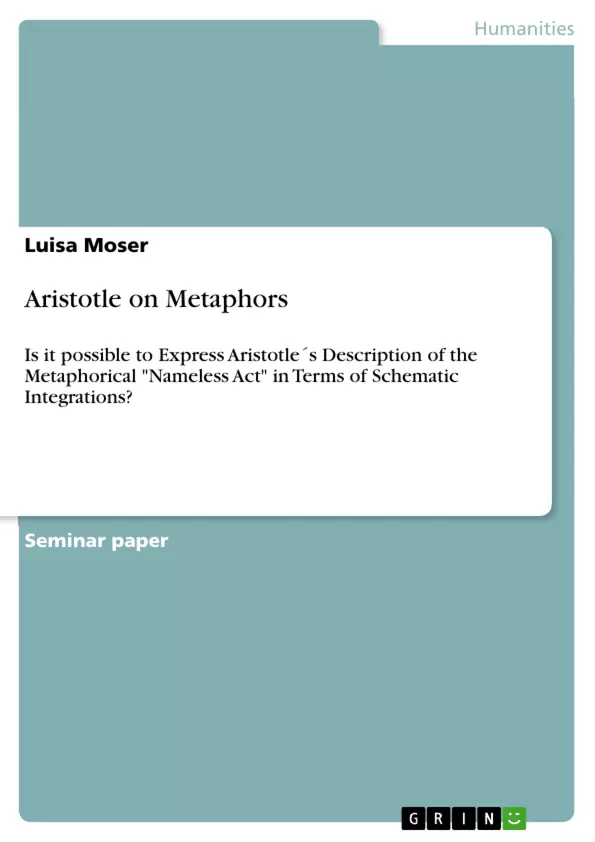The topic of Metaphors is both one of the most prolific and most demanding topics in linguistics and cognitive sciences. Tracing their investigative ontology, Aristotle is considered to be the first to write about them, with the purpose of analysing how they are constructed. In revising the relevance of Aristotle’s insights for the sciences in question, this paper raises the following question - Is Aristotle’s analysis of the creative process that gives rise to metaphors comparable to the recent results yielded by modern research?
Inhaltsverzeichnis (Table of Contents)
- Introduction.
- Approaching the Creation of Metaphors
- Schemas as Integral Elements of a Metaphor
- The Creation of Metaphors by Schematic Integration
- The Creation of Metaphor as Concept Invention
- The first Example of a Metaphor by Aristotle
- The second Example of a Metaphor by Aristotle
- Which underlying Concepts allow for the “Empty Slot” idea?
- Metaphorical Construction built by Schemas and Linguistic Structures
- Empty Slots and Nameless Parts.
- Conclusion and Outlook.
Zielsetzung und Themenschwerpunkte (Objectives and Key Themes)
This paper examines Aristotle's analysis of metaphor creation and compares it to contemporary cognitive science models, specifically those of schematic integration and concept invention. The primary goal is to assess whether Aristotle's approach aligns with modern research findings.
- The role of schemas in metaphor creation
- The process of schematic integration as a metaphor-building mechanism
- The concept invention approach to metaphor generation
- A comparative analysis of Aristotle's approach with modern theories
- The significance of "empty slots" and "nameless parts" in metaphor construction
Zusammenfassung der Kapitel (Chapter Summaries)
- Introduction: This chapter provides an overview of the importance of metaphors in language and highlights Aristotle's pioneering work in understanding their construction. It also introduces the two modern theories that will be compared to Aristotle's analysis.
- Approaching the Creation of Metaphors: This chapter presents Aristotle's description of the four types of metaphors and sets the stage for comparing his approach with modern theories. It introduces the concept of schemas and how they play a role in metaphor creation.
- Schemas as Integral Elements of a Metaphor: This chapter delves deeper into the role of schemas in metaphors, explaining how they act as underlying concepts that enable analogies and comparisons. It discusses how schemas are instantiated in various contexts, including metaphors.
- The Creation of Metaphors by Schematic Integration: This chapter focuses on the theory of schematic integration, exploring how the interaction of different schemas leads to the creation of metaphors. It compares this model with Aristotle's analysis and examines the role of "surprise" in metaphor comprehension.
- The Creation of Metaphor as Concept Invention: This chapter introduces the concept invention approach to metaphor generation, focusing on the creation of new concepts through the merging of existing ones. It explores how this model aligns with Aristotle's analysis and provides further insights into the construction of metaphors.
- The first Example of a Metaphor by Aristotle: This chapter examines the first example of a metaphor used by Aristotle, analyzing its structure and the underlying schemas involved. It relates Aristotle's example to the modern theories of schematic integration and concept invention.
- The second Example of a Metaphor by Aristotle: This chapter delves into the second example of a metaphor presented by Aristotle, exploring the underlying concepts and schemas that contribute to its construction. It examines how the metaphor is built through the interaction of schemas and linguistic structures.
- Which underlying Concepts allow for the “Empty Slot” idea?: This chapter investigates the concept of "empty slots" in metaphors and analyzes how the underlying concepts contribute to the formation of this idea. It relates this idea to Aristotle's theory and examines how it aligns with modern theories.
- Metaphorical Construction built by Schemas and Linguistic Structures: This chapter explores how schemas and linguistic structures work together to create metaphors. It examines the specific mechanisms involved in the construction of metaphors and compares them with Aristotle's analysis.
- Empty Slots and Nameless Parts: This chapter focuses on the concept of "empty slots" and "nameless parts" in metaphors, discussing their significance in metaphor construction. It relates these concepts to Aristotle's analysis and examines how they relate to modern theories.
Schlüsselwörter (Keywords)
This paper explores key concepts like metaphors, schemas, schematic integration, and concept invention, all within the framework of Aristotle's influential analysis of metaphor creation. It examines the role of image schemas in constructing metaphors, analyzing how these concepts relate to both Aristotle's approach and modern theories like schematic integration and concept invention.
- Quote paper
- Luisa Moser (Author), 2018, Aristotle on Metaphors, Munich, GRIN Verlag, https://www.hausarbeiten.de/document/1383406


